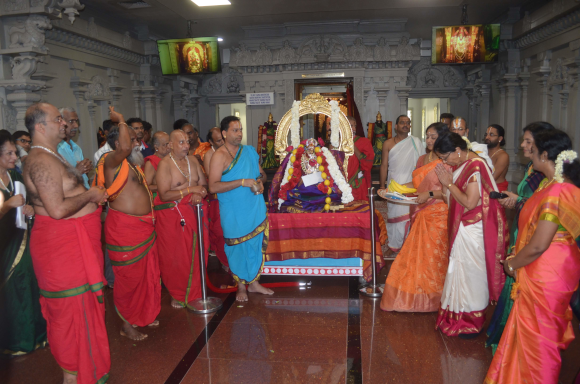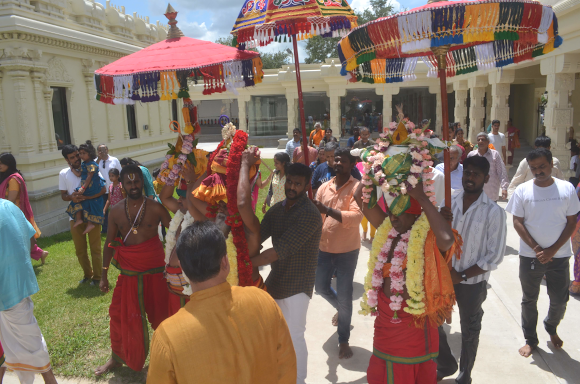Maha Homam for the Supreme Goddess at Sri Meenakshi Temple
 By MK Sriram
By MK Sriram
PEARLAND: It is said that in the present age known as Kali Yuga, worshipping Goddess Chandi and Lord Ganesha are of great importance. Goddess Chandi is the most powerful Divine Universal Mother. She is the combination of the Goddess triumvirate – Mahakali or Durga, Mahalakshmi and Mahasaraswathy. Like the God Rudra, she has two forms. In Her fierce form, she destroys the evil demons, whereas in Her resplendent and benevolent form she is most loving and compassionate.
It was a most remarkable weekend at Sri Meenakshi Temple as the Nava Chandi Maha Homam was conducted in a very grand manner. This is a very elaborate puja consisting of many rituals as ordained by the shastras, requiring highly learned priests with special skills and knowledge. The eminent MTS priests were joined by other distinguished priests to conduct this great puja and homam from Thursday Aug 16th till Sunday Aug 19th. All proceeds from this event is towards the Kalyana Mandapam Renovation Project. Hundreds of devotees attended every session each day and were completely immersed in the puja and mesmerized by the chanting of the mantras and various vedic hymns.

The main aspect of the puja is the recital of the Devi Mahatmyam. Among all the sacred texts that laud the glory of the Mother, Devi Mahatmyam is considered to be extremely auspicious and powerful. Devi Mahatmyam, or the Glory of the Goddess, describes the victory of the Devi Chandi over the asuras Madhu-Kaitabha, Mahishasura and Shumbha-Nishumbha. It comprises of 700 mantras and hence is called Saptashati. Though the Devi Mahatmyam consisting of 13 chapters is part of Markandeya Purana, it is not merely treated as a purana, but is considered a full-fledged scripture by itself. The yagasala where the slokas were recited became flooded with waves of vibration, purifying the entire area, invoking the presence of the Supreme Devi. The greatness of the Devi Mahatmyam is extensively explained in several ancient texts. The Devi
Mahatmyam has the ability to grant the fruits according to the upasana (worship). At one level, the Devi Mahatmyam chronicles the battle between the Devi and the asuras. At another level it deals with the battle of life. At yet another level it deals with the inner battle between the divine and the demoniac forces within the human psyche.

Several rituals were performed during the course of the four days, such as Ganapathy Homam, Navagraha Homam, Sri Lalitha Sahasranama Parayanam (recital), Sri Lalitha Sahasranama Homam, Devi Mahatmyam Parayanam and pujas for 64 Bhairavas and 64 Yoginis. Married couples (dhampathis) performed puja to Sumangalis. Pujas were also performed for Kanya girls and Bhairavar boys. It is believed that Goddess Chandi is invoked in these various forms.
The grand finale on August 19th was the Maha Chandi Homam performed simultaneously by nine priests on a specially constructed enormous homa kundam. A very large gathering of over 500 devotees witnessed probably the biggest and most elaborate yagna of their lifetime. Everybody experienced the supreme power of the Maha Devi. At the end of each of the 13 chapters, vastram and fruits were offered to the agni. The Vedic mantram Chamakam was chanted for Vasordhara during the final Purnahuthi offering. The kalasams or pots with the holy water were taken around the main temple in a procession and then abhishekam was performed for Sri Durga. After alankaram and deeparadhan, the most beautifully decorated utsava murthi was taken in a procession around the temple. The devotees savored each moment of this most powerful and grand yagna. They brought many many prasadams (offering) to Maha Devi. They were then treated to a most sumptuous lunch prasadam.
It is not easy to organize a Puja/Homam of such a grand scale, so it was no wonder this was happening after about 15 years at Sri Meenakshi Temple, in fact in Houston itself. Kudos to the Temple Board under the chairmanship of Dr Padmini Nathan and the entire Religious Activities Committee team of volunteers lead by Sheila Sriram for the meticulous preparation and execution. The priests led by Sri Manicka Bhattar did a phenomenal job. The Silpis (artisans) led by Ramanathan did most outstanding work, building the large homa kundam, installing the tents, and beautifully decorating them and many other tasks.
Overall, this was one signature event of MTS that will be remembered forever.
